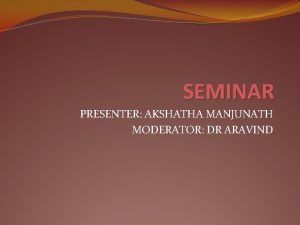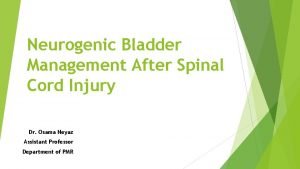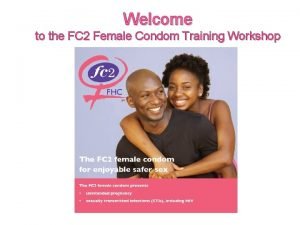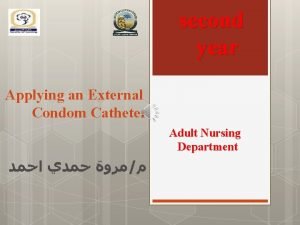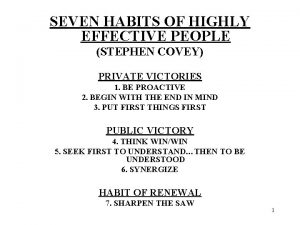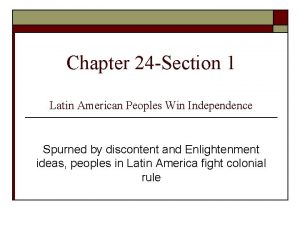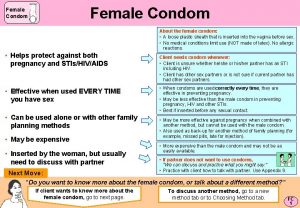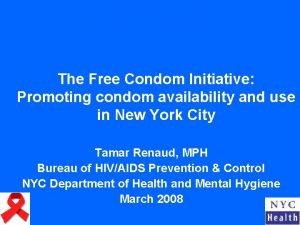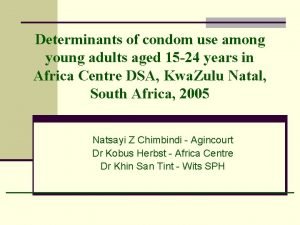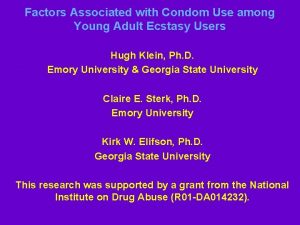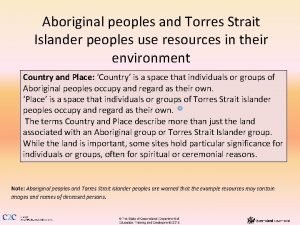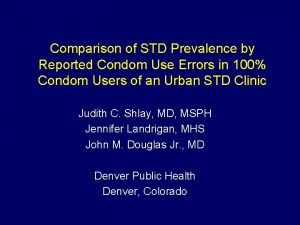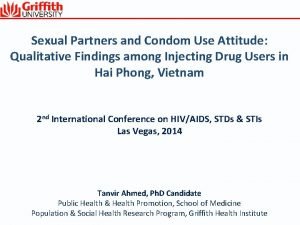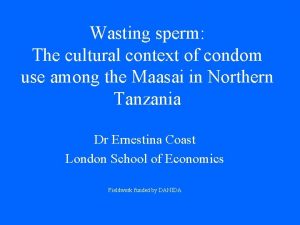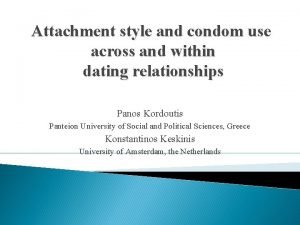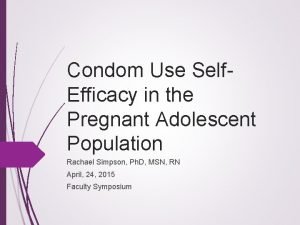An integrated theory of young peoples condom use














- Slides: 14

An integrated theory of young peoples’ condom use in Sub-Saharan Africa: A meta-analysis Dr Cleo Protogerou ¹ ² Martin S. Hagger ² ³ Blair T. Johnson 4 ¹University of Cape Town, South Africa, ²Curtin University, Australia, ³ University of Jyväskylä, Finland, 4 University of Connecticut, USA.

The present meta-analysis aimed to: 1. Develop the first integrated theory of core social cognitive constructs expected to be linked to condom use in Sub-Saharan African (SAA) youth 2. Test the impact of moderators (demographic, methodological) on the relations among the social cognitive constructs, and on intended and actual condom use

Variables in the integrated theory Hypothesized core social-cognitive antecedents Attitudes; norms; control; barriers; risk perceptions; intentions Outcomes of interest Intended & actual condom use frequency Hypothesized Moderators Age; gender; socio-economic status; predominant religion; geographical location; sample setting; study quality; inclusion of preliminary formative research; time since publication; time lag between social cognitive constructs and follow-up measures

Core health cognitions (Mc. Millan & Conner, 2007)

Moderator: A variable that affects the direction and/or strength of the relationship between a predictor variable (antecedent) and an outcome variable. Moderator (e. g. , study quality) Social-cognitive antecedent (e. g. , attitudes towards condoms) Outcome variable (condom use)

Methods: Data preparation Eligible studies included § Young people (up to age 35) from educational or noneducational settings § Cross-sectional, prospective, or intervention-type designs § Outcome measures of intended or actual condom use frequency § Bivariate correlations between core social-cognitive constructs and condom use § English articles & theses Search Strategy § Web of Science, Pub. Med, Psyc. INFO, Google Scholar (up to August 2016); Evidence Syntheses; Reference lists; Author contact Help!

Methods: Data Analyses § § Effect size measure: Averaged sample-weighted correlations (r+) among model constructs estimated using Hedges and Vevea’s (1998) methods & Field and Gillett’s (2010) SPSS macros Random-effects metaanalytic structural equation modelling with MASEM (Cheung, 2015) on R § § § Heterogeneity: I 2 & Q values Publication bias: Begg & Mazumdar’s test Quality Assessment: (EBL critical appraisal checklist: Glynn, 2006) Moderator analyses: Categorical & metaregression Sensitivity analysis 7

Results: Descriptive Statistics § 55 studies; 72 independent data sets; N = 55, 069 § Mean age = 19, SD = 3. 43 § More males: 23 studies (42%) had predominatelymale samples; 13 studies (24%) had male-only samples § About half studies were conducted in urban (k = 30, 54%) and school settings (k = 27, 49%) 13 SSA nations: Botswana, Cameroon, Ethiopia, Ghana, Guinea, Kenya, Namibia, Nigeria, Rwanda, South Africa, Tanzania, Uganda, Zimbabwe

Results: Path diagram of the integrated condom-use model

Path diagram of the integrated condom-use model including effects of past condom use

Results: Moderator effects § Little evidence of moderation § Heterogeneity in effect sizes was low in most cases § Six of the 25 effects were stronger in studies that included a formative research component (e. g. , pilot, qualitative study) Protogerou, C. , Johnson, B. T. , & Hagger, M. S. (2018). An integrated model of condom use in sub-Saharan African youth: A meta-analysis. Health Psychology, 37, 586 -602. .

Implications for research & practice We propose that investigators: 1. Opt for an integrated social-cognitive theory over an individual one 2. Include formative research 3. Develop interventions that target habits, attitudes, norms, control, and barriers to condom use – equally Protogerou, C. , Johnson, B. T. , & Hagger, M. S. (2018). An integrated model of condom use in sub-Saharan African youth: A meta-analysis. Health Psychology, 37, 586 -602.

Thank you for attending! Cleo Protogerou, Ph. D Citation: Protogerou, C. , Johnson, B. T. , & Hagger, M. S. (2018). An integrated model of condom use in sub-Saharan African youth: A meta-analysis. Health Psychology, 37, 586 -602. http: //dx. doi. org/10. 1037/hea 0000604 Funding: The Berkeley Initiative for Transparency in the Social Sciences (BITSS), a program of the Center for Effective Global Action (CEGA), with support from the William & Flora Foundation & The University of Cape Town’s Research Committee (URC). More at: www. cleoprotogerou. com Email: cleo. protogerou@uct. ac. za

References African Union Commission. (2006). African Youth Charter (Vol. 2017). Banjul, The Gambia: African Union Commission. Cheung, M. W. L. (2015). meta. SEM: an R package for meta-analysis using structural equation modeling. Frontiers in Psychology, 5, 1521. doi: 10. 3389/fpsyg. 2014. 01521 Field, A. P. , & Gillett, R. (2010). How to do meta-analysis. British Journal of Mathematical and Statistical Psychology, 63, 665 -694. doi: 10. 1348/000711010 X 502733 Glynn, L. (2006). A critical appraisal tool for library and information research. Library Hi Tech, 24, 387 -399. doi: 10. 1108/07378830610692154 Hedges, L. V. , & Vevea, J. L. (1998). Fixed- and random-effects models in metaanalysis. Psychological Methods, 3, 486 -504. doi: 10. 1037/1082 -989 X. 3. 4. 486 Mc. Millan, B. , & Conner, M. (2007). Health cognition assessment. In A. B. S. Ayers, C. Mc. Manus, S. Newman, K. Wallston, J. Weinman, & R. West (Ed. ), Cambridge Handbook of Psychology, Health and Medicine (2 nd ed. , pp. 260266). Cambridge, UK: Cambridge University Press. UNESCO. (2017). What do we mean by youth? Retrieved April 1, 2017, from http: //www. unesco. org/new/en/social-and-human-sciences/themes/youthdefinition/
 Female condom
Female condom Disadvantage of female condom
Disadvantage of female condom Subrapubic catheter
Subrapubic catheter Condom catheter
Condom catheter Micturition
Micturition Indice de pearl condom
Indice de pearl condom презервативы для женщин
презервативы для женщин Bu patientconnect
Bu patientconnect Condom catheter definition
Condom catheter definition Semitic peoples origin
Semitic peoples origin Seven habits paradigm
Seven habits paradigm John calvin peoples
John calvin peoples Chapter 8 section 1 latin american peoples win independence
Chapter 8 section 1 latin american peoples win independence Let me see your hands clap
Let me see your hands clap Latin american peoples win independence
Latin american peoples win independence



